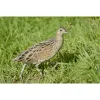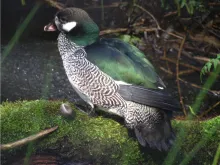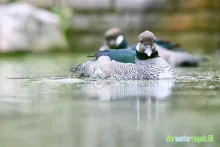
Green Pygmy Goose (Nettapus pulchellus)
Species name
- Dutch name:
- Groene pygmeegans
- English name:
- Green pygmy goose
- German name:
- Australische Zwergente
- French name:
- Anserelle élégante
- Scientific name:
- Nettapus pulchellus
Scientific classification
- Order:
- Anseriformes
- Family:
- Anatidae
- Onderfamilie:
- Oxyurinae
- Genus:
- Nettapus
Description
- Description:
Male:
(Breeding) Dark iridescent green crown, to below eye and neck, finely barred dark brown on the crown on the nape, with white face patch on lower cheeks and chin. Upper breast, flanks and vent pale grey, with dark green and white scallop markings; lower breast and belly white; undertail coverts dark grey. Mantle and scapulars dark iridescent green, becoming grey, with dark green barring, on lower back, rump and uppertail-coverts ; tail black. Primaries and primary coverts blackish, secondaries white, and secondary coverts iridescent green. Bill dark grey, with pink nail and underside. Legs and feet dark grey.(Non-Breeding) Slightly Duller less Iridescence and grey freckling on face and light mottling on foreneck.
Call:
Shrill whistling call.Female:
Has a white face with grey specking and a black eye stripe. Sides and front of neck lacking dark green and finely barred like upper breast.Call:
Whistling Call lower than the Male.Juvenile:
Similar to adult female but face chin and neck mottled dark brown. Green foreneck of males appears in first autumn, and both sexes as adults by the end of the first winter.
- Behaviour:
In Breeding time Green Pygmee geese become very vocal and display almost constantly and will fly up to nest boxes and show all the signs of wanting to breed. Males appear to take a significant part in the choosing of nest sites and will stand on nest boxes and very positively call the females to the box. When in breeding condition they may be quite aggressive to other waterfowl and the females when in condition may also be aggressive to males that are not in condition.
Standard Measurements
- Body Length (cm):
- The male (drake) of the Green Pygmy Goose measures approximately 30-36 centimeters. The female measures approximately 30-36 centimeters.
- Body Weight (grams):
- The male will weight about 310 gram. The female will weight about 310 gram.
The weight is notoriously variable and can only be used as indication!
- Habitat:
The Green Pygmy Goose is significantly larger than the African or Indian Pygmy Geese but like these species requires some protection from severe weather and ideally requires indoor accommodation during the winter but this requirement does not mean that they are a species that is more suited to a tropical house; although this might be ideal if the quality of the air and water could be controlled. In keeping with the African Pygmy Geese the Greens appear to be remarkably sensible and if provided with access to some sort of indoor set up that can provide frost free conditions during the winter they will invariably enter of their own accord and even during the summer they will tend to use the shelter at night. Only shut them inside if their outdoor pond actually freezes over!
Feeding is relatively simple and they enjoy a good quality Foreign Finch mix and will also take some wheat. Getting them to take any quantity of pellets is not easy but should be encouraged, they will take some floating pellets, relish a supply of greens, some meal worms and if it were possible to provide water Lilly leaves and seeds this would probably be appreciated and may be very beneficial. Maintaining in captivity is not straight forward, they appear prone to getting wet feathers on their backs and wing feathers and clearly this can lead to heat loss and subsequent hypothermia.
- Note:
Green Pygmy geese are delicate and breed extremely rarely in captivity. They may be best maintained fully-flighted in an aviary. A raised nest box should be provided. The normal laying period is May to September.
Ducklings apparently feed by straining small particles from the water. Feeding may be stimulated by rapidly moving fingers in a dish of water containing fine feed; this may be required for three weeks or more. Duckweed may also be useful to encourage feeding, but may itself be too large for young downies to eat. Supplemental tube feeding has been useful in downies during the initial rearing period.
Green Pygmy geese are cold-sensitive birds, requiring protection in prolonged cold spells.
A large open pond of natural water is important for breeding, although they may be maintained (not bred) in small aviaries. Good access to sunlight is recommended (minimal shade in enclosure). A log coming from the water is appreciated for roosting, so that the birds do not need to come onto land.
Breeding may be best if the birds are kept as a colony; males are aggressive to one another and fighting occurs but injury is rare. Wooden nest boxes, 30x30x48cm, with a 9cm diameter hole 12cm from the top of the box, placed over water on poles should be provided, with a ramp giving access to the box and nesting material (sawdust and fine shell grit) provided inside. Sitting females are very sensitive to disturbance and readily desert the nest; fostering under closely related species (e.g. Cotton pygmy-goose (Nettapus coromandelianus)) has been prefered for this reason.
- Breeding:
- The female Green Pygmy Goose usually lays from 8-12 creamy white and not shiny eggs and incubates them for 23-24 days.
- Artificial incubating:
The ideal relative humidity for incubating most waterfowl eggs is 55% (ground nesters) and 40% (cavity nesters). The temperature is usually 37.4°C. Set ventilation as recommended by the incubator manufacturer. Eggs must be turned, either automatically or by hand, a minimum of 4 times a day. As the duckling develops there is a loss of water from the egg and the air sac gets bigger. In normal development of an egg with a 23-24 days incubation, the air sac occupies about a third of it three days earlier. Cleanliness is vital and ideally eggs should be moved to a separate hatcher at this point, where the humidity should be increased to 65% and even higher once they have pipped internally.
- Bird banding:
- Recommended closed leg band ring size for the Green Pygmy Goose is 7 mm.The leg band ring can only be applied on a young perching duck at around 10 days old.
- It doesn't matter what leg that you band, but it's good to have a consistent system. Suggested: Left leg = Female, Right leg = Male
- Rearingfeed:
-






 Floatable special rearing feed for all ornamental waterfowl species, even for problematic eaters. This ideally balanced complete feed with 35% protein content forms the basis for healthy growth and lifelong vitality. Made exclusively from wholesome and selected raw materials, Lundi Micro is also ideally suited for the year-round feeding of waterfowl.
Floatable special rearing feed for all ornamental waterfowl species, even for problematic eaters. This ideally balanced complete feed with 35% protein content forms the basis for healthy growth and lifelong vitality. Made exclusively from wholesome and selected raw materials, Lundi Micro is also ideally suited for the year-round feeding of waterfowl.
- Maintenance food:
-






 Floatable special rearing feed for all ornamental waterfowl species, even for problematic eaters. This ideally balanced complete feed with 35% protein content forms the basis for healthy growth and lifelong vitality. Made exclusively from wholesome and selected raw materials, Lundi Micro is also ideally suited for the year-round feeding of waterfowl.
Floatable special rearing feed for all ornamental waterfowl species, even for problematic eaters. This ideally balanced complete feed with 35% protein content forms the basis for healthy growth and lifelong vitality. Made exclusively from wholesome and selected raw materials, Lundi Micro is also ideally suited for the year-round feeding of waterfowl.




